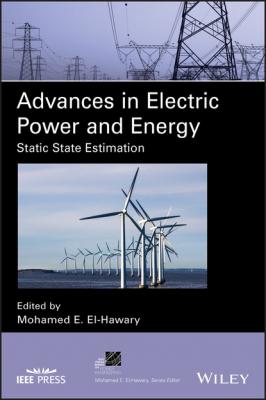Advances in Electric Power and Energy. Группа авторов
Читать онлайн.| Название | Advances in Electric Power and Energy |
|---|---|
| Автор произведения | Группа авторов |
| Жанр | Физика |
| Серия | |
| Издательство | Физика |
| Год выпуска | 0 |
| isbn | 9781119480440 |
Ten measurements are considered as shown in Figure 2.1: two voltage measurements at bus 1 and 2; two active/reactive power injection measurements at bus 1 and 3; three active power flow measurements at lines 1–4, 3–2, and 3–4; and one reactive power flow measurement at line 3–4. The standard deviation of any measurement other than voltage is 0.02, while the standard deviation of voltage measurements is 0.01. The considered measurement configuration provides a redundancy ratio of (10 + 2)/7 = 1.71. Note that the measurement set includes 10 actual measurements plus two exact measurements corresponding to active and reactive power injections at the transit bus.
The state estimation problem for this example has the form
minimizex
subject to 2 equality constraints for the transit bus and 7 inequality constraints enforcing physical limits:
Figure 2.1 One‐line diagram and measurement configuration of a 4‐bus power system.
TABLE 2.1 Line parameters.
| Bus i | Bus j | Bij (p.u.) |
|---|---|---|
| 1 | 2 | 10 |
| 1 | 4 | 10 |
| 2 | 3 | 10 |
| 3 | 4 | 10 |
2.3 CLASSICAL STATE ESTIMATION PROCEDURE
Traditionally, problem is simplified by ignoring inequality constraints (2.3) and then solving the system of nonlinear equations constituted by the first‐order optimality conditions of, i.e.
(2.8)
(2.9)
or
(2.10)
(2.11)
where W is a m × m diagonal matrix of the measurement weights wi, F = ∇xf (x) is the p × n equality constraint Jacobian, and λ is the p × 1 Lagrangian multiplier vector associated with equality constraints (2.2).
The nonlinear system of Eqs. can be solved by Newton through the iteration below:
where Δ z(ν) = z − h (x(ν)).
The linear system of Eqs. (2.12) is iteratively solved until Δ x is sufficiently small. Further details can be found in [7].
It should be noted that the solution approach based on (2.12) was developed at the time that no efficient mathematical programming solvers (in terms of accuracy, required computing time, and sparsity treatment) were available. However, such solvers are nowadays available.
Example 2.2 Classical Solution Example
The system in Figure 2.1 is considered in this example. In order to solve the nonlinear system by the Newton method, matrices H and F and vectors Δ z and f (x ) should be computed at each iteration. The diagonal terms of the measurement weight matrix W correspond to the inverse of the variance of the measurement errors. Expressions for these matrices are
The minimum and maximum active/reactive power injections in puMW/puMVar are
The initial solution considered for state variables is the flat voltage level, and a convergence tolerance of 10−5 on the largest Δxi is considered. The convergence, illustrated in Table 2.5, is obtained after four iterations.
TABLE 2.2 Voltages: measured, true and estimated values.
| Bus no. |
|
|
|
|
|---|
